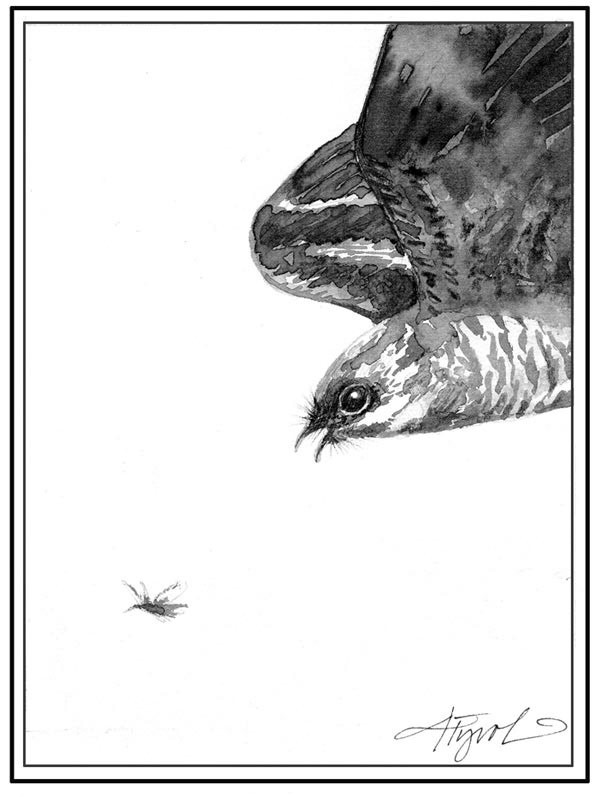
Some catch their prey while in flight; others sit and wait for prey to come near. They’re a group of birds known as aerial insectivores, and they’re in trouble. In our region, this diverse group consists of 19 species that, as their name implies, feed almost exclusively on flying insects. Some, such as the barn swallow and eastern phoebe, are quite common and well-known, while others, such as the olive-sided flycatcher and eastern wood-pewee, are relatively unknown to non-birders. Unfortunately, as a group, aerial insectivores have been declining steadily across northeastern North America for the last 25 years or so. Flycatchers, swallows, and nightjars (the whip-poor-will and common nighthawk) have been particularly affected.
While declines in some groups of birds can be attributed to the loss of a specific habitat type (such as grassland), aerial insectivores occupy a wide variety of habitats. For example, within the flycatcher group alone there are species that nest in montane and boreal forests, wetlands, deciduous woodlands and conifer-dominated forests. They also have a range of life history traits, from ground-nesting nocturnal species, to colonial cavity-nesters, to those that rely primarily on human structures for nest sites.
The common feature of these birds is that they all feed on insects captured in flight, suggesting that declines are more likely connected to broad-scale changes in insect populations or the timing of when insects become available as a food source. When we look at which aerial insectivores are declining based on how they capture their prey and how far they migrate, interesting patterns emerge.
Aerial insectivores can be divided into two groups, hawkers and salliers. Hawkers are those that fly while feeding, and include all the swallows, the chimney swift, purple martin, and common nighthawk. Salliers, on the other hand, sally out from a perch, nab a flying insect, and immediately return to their perch. This large group includes all the flycatchers, the cedar waxwing, eastern kingbird, and whip-poor-will. Overall, salliers seem to be in less trouble, with some flycatchers showing modest increases in Vermont and New Hampshire bird surveys. Hawkers, however, appear to be experiencing widespread problems, so much so that both the chimney swift and barn swallow have been listed as “threatened” in Canada. Although the reasons for these declines are unknown, many speculate they are related to changes in food supply specific to hawkers, possibly driven by climate change.
Results from the recently published, Second Atlas of Breeding Birds of Vermont, show that 13 of 18 aerial insectivore species have declined when compared to results from the first Vermont bird atlas 25 years ago. The biggest losses were for common nighthawk and whip-poor-will, the only nocturnal foragers in the group. Some suggest the loss of these two species is due to a decline in giant silk moth populations, which in turn is the result of a parasitic fly brought in from Europe to control gypsy moths (another non-native species).Unfortunately, the fly not only kills gypsy moth caterpillars, but other native moth species as well.
Others suggest that our burgeoning human population has resulted in an ever-increasing amount of artificial lighting at night, disrupting nocturnal insect behavior. For light-sensitive insects, life is too short to spend much of it flying aimlessly around a porch light.
Aerial insectivores can also be divided based on their migratory strategy—some overwinter in South America, while the majority overwinter in Central America. The species that travel to South America are faring worse than those that travel shorter distances. Again, this difference could have something to do with the food supply on wintering grounds, combined with the increased energetic demands of long-distance migration. It may also be related to pesticide use, habitat loss, or changes in agricultural practices on wintering grounds or along migratory routes.
Fortunately, population sizes of most aerial insectivores are sufficiently large so that meaningful scientific studies can be conducted. However, at the current rate of decline, populations will be greatly reduced over the next decade or two, so time is critical. According to ornithologist Jon McCracken, if research shows that changes in food supply is the driving force behind aerial insectivore decline, “there are potentially very large ecological and socio-economic ramifications, particularly if pollinators are part of the picture. All in all, the plight of aerial insectivores is not only food for thought, but a call to action.”


Discussion *